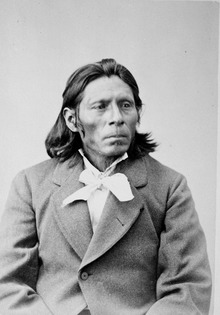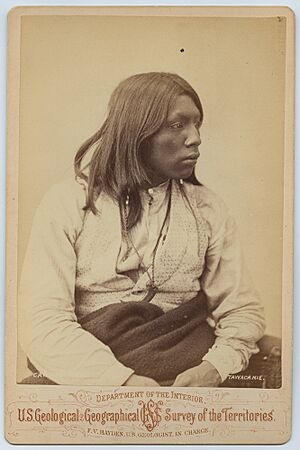Tawakoni facts for kids

Dave, a Tawakoni man, 1872
|
|
| Total population | |
|---|---|
| fewer than 2,953 (2018) | |
| Regions with significant populations | |
| Languages | |
| English, formerly Wichita | |
| Religion | |
| Native American Church, Christianity, indigenous religion |
|
| Related ethnic groups | |
| Caddo, Pawnee, other Wichita and Affiliated Tribes |
The Tawakoni are a Native American tribe from the Southern Plains region. They are closely related to the Wichita tribe. Historically, they spoke a language called Wichita, which is part of the Caddoan language family. Today, Tawakoni people are officially part of the Wichita and Affiliated Tribes. This is a group of tribes recognized by the United States government.
Contents
The Tawakoni Story: A Look at Their Past
The Tawakoni people have a rich history that spans centuries. Their journey involved moving across different lands and interacting with many groups. They faced challenges but also formed important alliances.
Early Life and French Contact
In the early 1700s, the Tawakoni lived in villages. These villages were located in areas that are now Oklahoma and Texas. They were known for their farming skills.
In 1719, a French explorer named Jean-Baptiste Bénard de la Harpe met a Tawakoni village. This village was in what is now Muskogee County, Oklahoma. The French explorers noted that the Tawakoni grew maize (corn) and tobacco. La Harpe worked to create a peace treaty. This treaty was between the Tawakoni, eight other tribes, and the French government.
Moving South and Spanish Relations
Later, conflicts with the Osage tribe caused the Tawakoni to move south. They settled in Texas. In Texas, the Tawakoni became close allies with the Waco tribe.
For a long time, they were friendly with the French. However, they were often in conflict with the Spanish. In 1772, a Tawakoni Chief named Quiscat traveled to San Antonio. He tried to make peace with the Spanish. But this peace did not last very long.
Challenges and Treaties with the United States
By the 1820s, European-American settlers began to arrive. They often fought with the Native American tribes. Diseases also spread, which greatly reduced the number of Tawakoni people.
Stephen F. Austin's Republic of Texas eventually forced the tribes out of central Texas. The Tawakoni played an important role in history. They helped convince the Comanche and Wichita tribes to sign a peace treaty with the United States government. This was a very important moment. It was the first treaty signed between Plains Indians and the US.
In 1835, the Tawakoni signed another treaty. This one was with the United States at Camp Holmes. This was the first time they were grouped with the Wichita peoples. This practice continued in later treaties, signed in 1837 and 1846.
Life on Reservations
In 1853, a special area called an Indian reservation was created. It was located on the upper Brazos River in Texas. However, settlers eventually forced the tribes to leave this reservation.
In August 1859, 258 Tawakoni people had to move. They relocated to Indian Territory, which is now Oklahoma. In 1872, the Tawakoni settled on a new reservation. They were joined by the Wichita, Waco, Caddo, Nadaco, Kichai, and Hainai tribes. This reservation was located between the Canadian and Washita Rivers.
The United States government later introduced a policy called the Dawes Act. This act aimed to divide tribal lands into individual plots. The Tawakoni and other tribes resisted this policy. However, their reservation was eventually divided. Any "extra" land was then opened up to non-Native settlers on August 6, 1901.
By 1894, records showed there were 126 Tawakoni people. In 1934, the Oklahoma Indian Welfare Act was passed. Under this act, the Tawakoni joined other Wichita peoples. Together, they organized a new tribal government.
What Does "Tawakoni" Mean?
The name "Tawakoni" has a special meaning. It translates to "river bend among red sand hills." This name likely describes a place where the tribe once lived.
The Tawakoni name has been spelled in different ways over time. Some of these spellings include Touacara, Tahwaccaro, Tahuacaro, Towoccaro, Tehuacana, and Towakoni. Some French explorers even called them the "Three Canes" or Troiscanne.
Places Named After the Tawakoni
The Tawakoni tribe has left its mark on the map. Several places are named after them, especially in Texas:
- Lake Tawakoni in Texas is named for the tribe.
- The cities of East Tawakoni, West Tawakoni, and Quinlan, Texas are located around this large lake.
- The Sabine River flows out of the dam of Lake Tawakoni. This river goes through northeast Texas and forms part of the eastern border of Texas.
- Tehuacana Creek, Tehuacana Hills, and Tehuacana, Texas, are also named after the tribe. These names use a Spanish spelling of Tawakoni.


